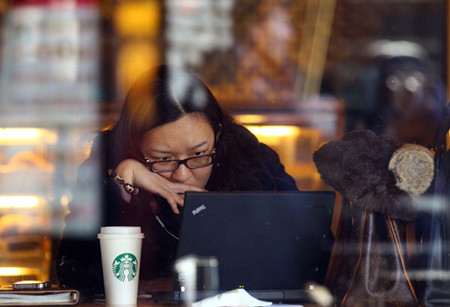
A customer is absorbed in thought at Starbucks in Sanlitun, Beijing, on Tuesday. Zou Hong / China Daily
Prices on par with US fail to deter Chinese customers who want a taste of 'the good life', report Gao Changxin in Shanghai and Wang Jingshu in New York.
Su Nan stood inside a Starbucks on Shanghai's bustling Huaihai Road and complained about the US coffee chain's recent price hike. "It's already expensive. How am I going to live?"
But the 26-year-old still joined a long line for a latte.
The world's biggest coffee chain raised the price of some products on Jan 31, due to what it said were rising operating costs. That brought Su's 16-ounce (about half a liter) "grande" cup to 30 yuan ($4.75) from 28 yuan.
Starbucks was already an expensive choice for regular Chinese customers such as Su, who earns about 7,000 yuan a month. One cup of cappuccino a day for a year would cost her 10,950 yuan - about one-eighth of her income.
Still, Su is better off than many others. China's per capita GDP last year was $5,184. It was $48,147 in the US.
Despite a huge gap in personal income, Starbucks has priced its products almost the same in China as in the US, if not higher, since it entered the Chinese market in 1999.
It also raised prices recently in the US Northeast and Sunbelt, by an average of about 1 percent. In New York, a 12-ounce latte now sells for $2.85 and plain brewed coffee was $1.65. The price of a 16-ounce, "grande" cup of coffee is unchanged at $2.20 plus 20 cents in local tax.
But Chinese consumers, who traditionally drink tea and have little taste for coffee, seem not to mind paying a relatively higher price. They have become one of the engines of growth for Starbucks.
The company has become so popular in China that it opened its 500th store in October, in Beijing, and plans to triple the number by 2015. Globally, Starbucks had 17,003 stores in 58 countries as of Oct 2.
In China, it's expanding not just in the big and rich areas but also in so-called second-tier cities, where consumers have much less disposable income. In December, Starbucks announced it had entered five more Chinese cities, including Langfang in Hebei province, which can hardly be rated as second-tier. Annual per-capita GDP is just above $3,000.

Copyright ©1999-2011 Chinanews.com. All rights reserved.
Reproduction in whole or in part without permission is prohibited.